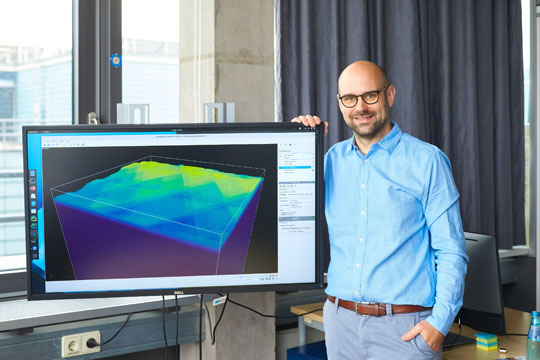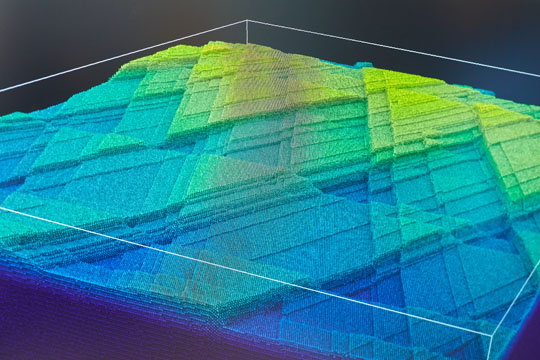Close Proximity that Generates Energy
Freiburg, Aug 11, 2020
It is not possible to look between two surfaces that are touching each other, which is why the microsystems engineer Prof. Dr. Lars Pastewka is simulating the contact between two surfaces in the excellence cluster livMatS – Living, Adaptive and Energy-autonomous Materials Systems at the University of Freiburg. He wants to find out more about the type and amount of contact points between surfaces in order to optimize the triboelectric effect (TBE), a phenomenon through which electricity is generated when surfaces touch and then separate. However, there is a catch: Very few surfaces are truly flat (flat is good for TBE), and these have hardly any contact when touching (not good for TBE).
 The microsystems engineer Lars Pastewka is researching how electricity can be harvested when surfaces touch and then separate. Photo: Harald Neumann
The microsystems engineer Lars Pastewka is researching how electricity can be harvested when surfaces touch and then separate. Photo: Harald Neumann
Surfaces look like the Himalayas when viewed under a microscope. “There are no surfaces that are absolutely flat in nature,” says Lars Pastewka, Professor of Simulation at the Department of Microsystems Engineering (IMTEK) of the University of Freiburg. Even completely smooth surfaces look like a mountain range when sufficiently magnified. Pastewka is working to optimizing the triboelectric effect (TBE) for a collaborative project at the livMatS cluster of excellence. TBE refers to the process in which electricity is created when surfaces touch and then separate. How this happens is not yet fully understood in detail. This is because it is impossible to look between two surfaces when they are touching. However, Pastewka believes he has found a solution to this problem: He creates models of the close proximity of surfaces on the computer. “We use simulations as virtual microscopes,” he says.
“Surface contact is virtually zero”
Researchers at livMatS are developing novel materials inspired by nature that behave as if they are alive, meaning for example they can move, react, or adapt. According to Pastewka, “The material systems have to take care of their energy needs themselves. They should be self-sufficient.” TBE would be a possible way to harvest energy from the materials’ surroundings. “When two surfaces touch, a transfer of electric charge occurs between them,” he says. When they separate, each surface is left with its own charge. This charge can be harvested as electricity. “The only triboelectric generators we have so far are based on trial and error,” Pastewka says, adding: “We want to fundamentally understand this effect, so that we can utilize it systematically.”
One thing Pastewka would like to know is what optimal surfaces should look like. Smooth, hilly, or mountainous? Common surfaces that appear to be smooth do not really touch each other because of their Himalayan structure, he explains, adding: “The contact surface is virtually zero.” Three submicroscopic contact points – in other words, three large Himalayan mountains – are enough to create stable conditions that would also be responsible for the charge separations that cause TBE. “When rough surfaces become distorted, like when we press them together, we get more contact points,” he says. When the Himalayan peaks are pressed flat, more points touch.
 Simulations as virtual microscopes: Pastewka uses a computer to determine what optimal surfaces for harvesting energy should look like.
Simulations as virtual microscopes: Pastewka uses a computer to determine what optimal surfaces for harvesting energy should look like.
Photo: Harald Neumann
Good hypotheses are the basis for simulations
There are also forces of attraction between contact surfaces, like Van der Waals forces, which are not very strong. “However, these forces could let a one cent coin hold objects that weigh a ton if there is 100% surface contact,” says Pastewka, who wrote his diploma thesis in the same microsystems engineering laboratory where he is now professor. The more contact points between surfaces, the stronger they adhere to each other and the more energy it takes to separate them. That is why Pastewka’s simulations focus on how this influences the harvesting of TBE. He believes that “the contact surfaces probably need to be hillier.” Tribological experiments also suggest that the Himalayas mixed with elasticity could be the best solution.
Pastewka’s team of ten researchers is therefore simulating how surface roughness and elasticity affects TBE. “It is important to have a good hypothesis before starting a simulation,” Pastewka emphasizes, adding: “For that, you need experience, intuition, and a little luck.” Take, for example the hypothesis that the charges exchanged by surfaces in TBE are found on the Himalayan peaks. Before conducting a simulation, Pastewka and his team must convert this hypothesis into algorithms. Because simulations always represent simplified versions of situations, the researchers include what they believe is important and leave out the rest. This makes simulations more manageable, also for the mainframe computers. Otherwise, they would run simulations for an endless amount of time. Processing time is limited, however. In the end, Pastewka’s model either has either failed or it works, disproving or proving his initial hypothesis. “After this, the results must be confirmed in practice in validation studies,” he says.
Arriving at a conclusion in finite time
Pastewka is also involved in a second collaboration at livMatS in which he simulates various designs for unit cells in metamaterials. Intelligent material systems are composed of millions of these building blocks, which are smaller than dust particles. If and how these systems can independently change their shape, for example, depends on the composition of their unit cells. In this collaboration, these are developed with much technical skill and brain power by microengineer Prof. Dr. Chris Eberl, who is also at IMTEK. “We are currently simulating various designs and their characteristics,” Pastewka says, adding: “At some point in the future, the computer should automatically be able to find the best designs for unit cells with certain characteristics.”
Pastewka hopes that the TBE collaboration will be able to present prototype systems in three to four years. “My lab is doing quantitative and qualitative research of macroscopic and microscopic interactions between surfaces,” he says. Prof. Dr. Michael Moseler from the Fraunhofer Institute for Mechanics of Materials IWM is simulating the atomic interactions, while the materials are being developed by Dr. Birgit Esser, Professor of Molecular/Organic Functional Materials at the Institute of Organic Chemistry of the University of Freiburg. Dr. Peter Woias, Professor of the Design of Microsystems at IMTEK, and Dr. Jürgen Rühe, Professor of the Chemistry and Physics of Interfaces also at IMTEK, are lending the materials structured Himalaya-like surfaces. However, before Woias can build triboelectric generators, Dr. Bizan Balzer from the Institute of the Physical Chemistry of Surfaces analyzes the surfaces with atomic force microscopy.
“Our simulations have just gotten underway,” says Pastewka, who in addition to microsystems engineering also studied physics at the University of Freiburg. He earned a PhD at the IWM and worked as a postdoc and junior lab head at Johns Hopkins University in the US and Karlsruhe Institute of Technology (KIT), after which he brought a Starting Grant from the European Research Council (ERC) with him when he took his position as a professor at IMTEK. Parallel to conducting simulations, his lab also studies test materials in collaboration with partners who conduct practical experiments. These test readings are then used in models designed to solve the TBE puzzle. This explains Pastewka’s greatest scientific wish: “I want to develop a comprehensive theory about tribology and prove it with a simulation – in finite time.”
Jürgen Schickinger

